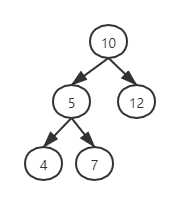二叉树中和为某一值的路径
- 题目:输入一颗二叉树和一个整数,打印出二叉树中节点值的和为给定值的所有路径。从树的根节点开始往下一只到叶子节点所经过的节点形成一条路径。
- 我们用二叉树节点的定义沿用之前文章中 二叉查找树实现原理定义。如下:
public class BinaryNode implements Comparable {private Object element;private BinaryNode left;private BinaryNode right;private int count;
- 案例:输入如下图中二叉树和整数22,打印出两条路径,第一条包含节点10, 12,第二条包含10,5,7

- 二叉树的节点定义中,我们是无法得到树的路径这个概念值的,应为二叉树中并没有介绍树的路径的数据结构,因此对于大多数人而言,这个是一个新的理论模型,也就很难一下找到思路,我们从一个案例入手更加简单,还是用上面的案例:
- 由于路径就是根节点出发到叶子节点,也就是说路径总是以根节点为起点,因此是先根遍历,也就是我们可以用二叉树的前序遍历,根,左,右的遍历方式,在我之前的文章 数据结构与算法–二叉树实现原理 中详细介绍了三种遍历方式并附带源码,我们以前序遍历为思路解这个问题。
- 按前序遍历范问上图,10,5,4,7,12 是前序遍历的顺序,我们可以从二叉树结构中看到,没有指向父节点的指针,因此范问5 的时候并不知道10 节点的路径和值,因此我们需要把上一个节点经过的路径保存下来,每次范问一个节点都将当前节点的路径添加到下一个节点的路径中,因此到达5 时候,因存 10,5接着到大4,总和为9 != 22.因此返回5节点,到达7 ,和为 10+5+7 = 22 符合提议,接着返回10 ,访问12,10+12 = 22 符合题意,因此有两组解
- 按如上分析有如下步骤:
- 安前序遍历递归实现二叉树的遍历
- 范问每个子节点之前将本节点走过的路径path和 路径和count传递给需要范问的子节点
- 字节点范问之前将父节点路径path添加上自己的路径 path+element,路径和添加自己的节点权重 path+weight
- 如果范问节点没有子节点,则比较路径和count 是否和目标 值一致,一致则正解。
- 如下实现,此处构造二叉树的方法沿用之前文章:数据结构与算法–二叉查找树实现原理中方法
/*** 二叉树中查找和为n 的路径** @author liaojiamin* @Date:Created in 10:51 2021/5/17*/
public class FindPathInBinary {public static boolean findPath(BinaryNode binaryNode, Integer target) {List<Integer> list = new ArrayList<>();list.add(Integer.valueOf(binaryNode.getElement().toString()));Integer count = Integer.valueOf(binaryNode.getElement().toString());return findPath(binaryNode, list, count, target);}public static boolean findPath(BinaryNode binaryNode, List<Integer> beforePath, Integer beforeCount, Integer target) {if (binaryNode.getLeft() == null && binaryNode.getRight() == null) {printPath(beforePath);System.out.println("beforeCount:" + beforeCount);if(beforeCount == target){System.out.print("存在路径:");printPath(beforePath);System.out.println();}return false;}if (binaryNode.getLeft() != null) {BinaryNode left = binaryNode.getLeft();Integer count = beforeCount + Integer.valueOf(left.getElement().toString());List<Integer> list = new ArrayList<>();list.addAll(beforePath);list.add(Integer.valueOf(left.getElement().toString()));findPath(binaryNode.getLeft(), list, count, target);}if(binaryNode.getRight() != null){BinaryNode right = binaryNode.getRight();Integer count = beforeCount + Integer.valueOf(right.getElement().toString());List<Integer> list = new ArrayList<>();list.addAll(beforePath);list.add(Integer.valueOf(right.getElement().toString()));findPath(binaryNode.getRight(), list, count, target);}return false;}public static void printPath(List<Integer> objectList) {for (Object o : objectList) {System.out.print(o);System.out.print(",");}}public static void main(String[] args) {
// Integer arr[] = new Integer[]{44,94,92,23,42,13,7,76,70,40,78,28,78,36,14,53,10,91,36,15};Integer arr[] = new Integer[]{10,5,4,7,12};BinaryNode node = new BinaryNode(null, null, null);BinarySearchTree searchTree = new BinarySearchTree();for (int i = 0; i < arr.length; i++) {int num = arr[i];node = searchTree.insert(num, node);System.out.print(num+",");}System.out.println();System.out.println();findPath(node, 22);}}- 该问题考察的是二叉树遍历的变种,考察复杂问题的思维能力,当一下没有思路,我们可以从具体案例开始分析,这样就能找出其中规律
上一篇:数据结构与算法-- 二叉树后续遍历序列校验
下一篇:数据结构与算法–复杂链表的复制
![[Java基础]内部类基础](http://pic.xiahunao.cn/[Java基础]内部类基础)


![[Java基础]Math类的常用方法](http://pic.xiahunao.cn/[Java基础]Math类的常用方法)


![[Java基础]System类的常用方法](http://pic.xiahunao.cn/[Java基础]System类的常用方法)


![[Java基础]Object类的常用方法](http://pic.xiahunao.cn/[Java基础]Object类的常用方法)


![[Java基础]Arrays的常用方法](http://pic.xiahunao.cn/[Java基础]Arrays的常用方法)

![[Java基础]int和String的相互转换](http://pic.xiahunao.cn/[Java基础]int和String的相互转换)

![[GitHub] 75+的 C# 数据结构和算法实现](http://pic.xiahunao.cn/[GitHub] 75+的 C# 数据结构和算法实现)
)
)
